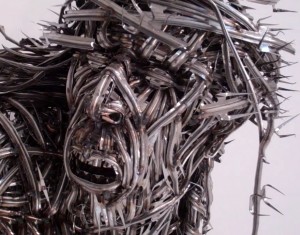The trophy wolf
There’s another week left to see Who’s afraid of the big bad wolf, an installation involving various media—sculpture, drawing, video, and, well, taxidermy—at David Zwirner. It’s the latest from Adel Abdessemed, an Algerian artist, whose past work has aroused the wrath of animal activists. This show might irk them as well, though it’s not clear that he abused any living creatures in the process of putting it together. The installation is mostly about how we turn our own worst impulses into a trophy of victory, and it revolves around issues of the relationship between violence, power, entertainment, and the natural world. That’s a lot of ground to cover coherently, but coherence isn’t the goal here—instead you get an eerie and strangely serene impression of beauty as you move through the exhibit, which raises questions about how people condone and hide from the reality of violence. Abdessemed has created a series of horrific images, representing the worst aspects of how human beings inhabit their world, and yet has managed to invest them with a beguiling, if occasionally slick, sense of economy and formal perfection. The show is unfeeling, impersonal, cerebral, and yet gorgeous. If that series of adjectives doesn’t make you uneasy, then you aren’t paying attention to the show. How he achieves this kind of visual charm in, for example, an enormous assemblage of actual animal carcasses is a bit of a mystery, and that’s what’s disturbing and riveting. You don’t want to look away when you should be averting your eyes with disgust. Anyone familiar by now with something called the Internet shouldn’t be surprised to feel those opposing impulses at once.
As you walk in, you see a boat, found abandoned in the Florida Keys, that previously held refugee immigrants. He has filled it with stuffed garbage bags. (I hear an ironic take on: Bring me . . . the wretched refuse of your teeming shores.) Next, there’s a resin sculpture that depicts a head-butting incident at the 2006 World Cup in Germany, which seems to coalesce nearly all of the concerns of the exhibit: how violence becomes something we watch with interest, if not pleasure, as we are invited to do with this exhibit itself. Another room is decorated with dozens of charcoal line drawings of animals, each with a pack of dynamite strapped to its back: they’ve been turned into suicide bombers. There is a looping video, similar in theme, of a baboon spelling out the words Hutu and Tutsi, the names of warring tribes in Rwanda, which seems glib and disposable and dull compared to the rest of the show. But exhibits best two works drive home Abdessemed’s notion that we blind ourselves to the reality of our violent relationship to nature and ourselves by turning acts of violence into an amusement or simply a decoration. In one exhibit space, he’s hung his enormous and astonishing fusion of animal carcasses into a rectangle with the exact dimensions of Picasso’s Guernica. Once again, animals are recruited in his work to represent the horror of war—and these carcasses have not only been fused together in a way reminiscent of Rodin’s Gates of Hell, they’ve been burnt so that the entire surface fluctuates between the blackened char of the hides and the varied earth tones of what’s left of the pelts. The effect is chillingly powerful and beautiful—though the beauty drops away as you get closer and what takes over is what Edmund Burke called the sublime: you see death itself in the frozen claws, teeth, hooves, eyes, at which point you realize you’re looking at what’s left of what was once a fox or wolf or deer. It’s creepy and astonishing. As you step away, you realize the work is essentially a parody of taxidermy and the practice of hanging animal heads on a wall as a trophy of the hunt. Winning! as Charlie Sheen would say.
Finally, on exactly the same note, in the companion exhibit space, Abdessemed has hung four images of Christ, crucified, sculpted with razor wire. They hang in a row on the wall, mimicking the familiar repetitions and redundancies of modernist art, each one a marvel that powerfully captures the anatomy of the human form, in which the crown of thorns has essentially become the body of its host. You see the entire shape has been molded of razor wire, bristling with its little knives. The face of Christ looks strangely threatening, angry, almost a personification of the passions that have taken his life, yet because of the medium, the figure also looks a bit like a character from a movie based on a Marvel comic. Razor Wire Man, sparkling with shining highlights, before he’s brought back to life with CGI. The meaning of the Crucifixion, and the quiet victory that followed, has been completely expunged from the image as it becomes a wall hanging. The way in which the dying figure is mounted, without a cross, brings home the theme of the show: how human beings can turn the most horrific acts of violence, and the depredations of history, and even the most profound spiritual truths, into an amusement, something to adorn the wall or enjoy with a box of popcorn, and simply admire because of the pleasant way it gives off light.

Comments are currently closed.